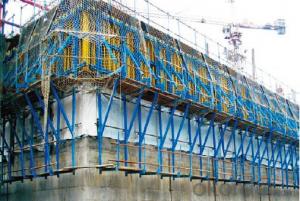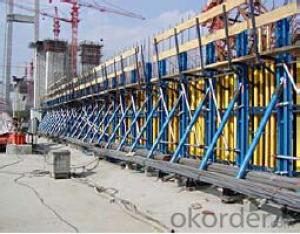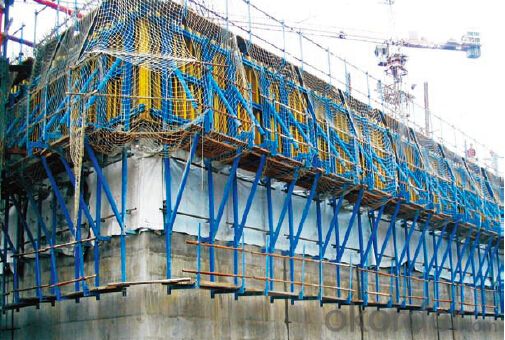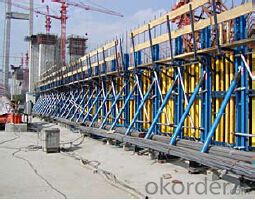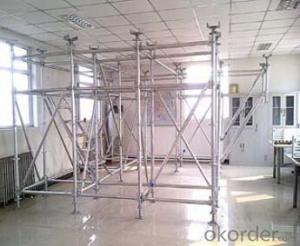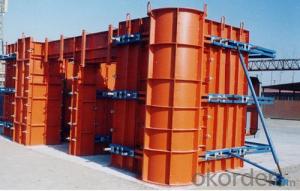Single-side climbing bracket SCB40 for formwork and scaffolding system
- Loading Port:
- Tianjin
- Payment Terms:
- TT OR LC
- Min Order Qty:
- 50 m²
- Supply Capability:
- 1000 m²/month
OKorder Service Pledge
OKorder Financial Service
You Might Also Like
Single-side Climbing Bracket SCB180:
With CNBM SCB 180 climbing systems, the loads from the fresh concrete pressure are
transferred through the brackets by means of V-strongbacks and compression braces into the
scaffold anchors.
Typical applications for the SCB 180 are dams, locks, cooling towers, pier heads, tunnels, and
bank vaults.
The formwork is simply tilted backwards when striking takes place. The 1.80 m wide bracket
requires only a minimum of space.
Characteristics:
◆ Economical and safe anchoring
The M30/D20 climbing cones have been designed especially for single-sided concreting using
SCB180 in dam construction, and to allow the transfer of high tensile and shear forces into the still
fresh, unreinforced concrete. Without wall-through tie-rods, finished concrete is perfect.
◆ Stable and cost-effective for high loads
generous bracket spacings allow large-area formwork units with optimal utilization of the bearing
capacity. This leads to extremely economical solutions.
◆ Simple and flexible planning
With SCB180 single-sided climbing formwork, circular structures can also be concreted without
undergoing any large planning process. Even use on inclined walls is feasible without any special
measures because additional concrete loads or lifting forces can be safely transferred into the
structure.
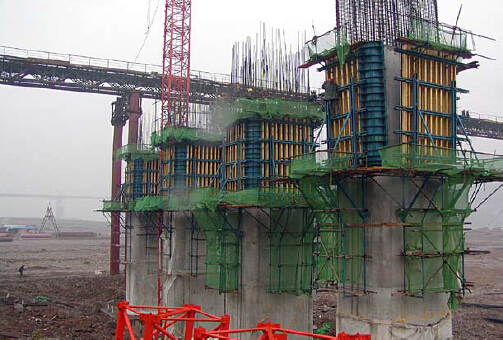
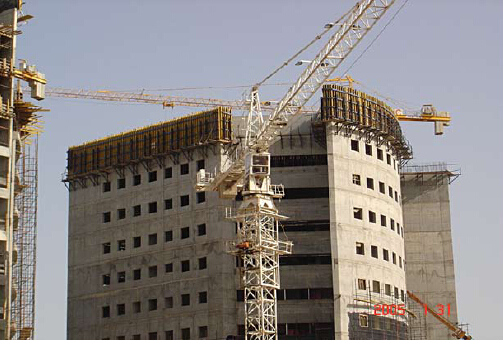
- Q: Can steel formwork be easily modified or adjusted during construction?
- Certainly, modifications or adjustments to steel formwork can be easily made during the construction process. Steel formwork is renowned for its ability to be flexible and adaptable, enabling convenient and swift modifications to meet project specifications. The design of steel formwork systems ensures modularity, enabling effortless assembly and disassembly, thereby facilitating simple modifications or adjustments to the formwork structure. Furthermore, steel formwork can be effortlessly cut, welded, or bolted together to produce custom formwork shapes or sizes. This adaptability of steel formwork makes it the preferred choice for construction projects that frequently require modifications or adjustments.
- Q: How does steel formwork handle different concrete crack control measures?
- Steel formwork is an excellent choice for accommodating different concrete crack control measures due to its inherent strength and durability. It is capable of withstanding the pressure exerted during the curing process, reducing the risk of cracks caused by formwork deflection. Additionally, steel formwork allows for tighter control over the placement of reinforcement and use of expansion joints, which are effective measures for preventing cracks. Overall, steel formwork provides a reliable and versatile solution for addressing various crack control measures in concrete construction.
- Q: Can steel formwork be used in corrosive environments?
- Corrosive environments can indeed accommodate the use of steel formwork. Steel is renowned for its durability and strength, making it a suitable option for construction purposes even in corrosive surroundings. However, certain precautions must be taken to ensure its long-term performance. One common precautionary method involves the application of protective coatings such as epoxy or zinc to the steel formwork. These coatings create a barrier that prevents direct contact between the steel and corrosive elements, thereby reducing the risk of corrosion. Another alternative is the utilization of stainless steel formwork, which possesses inherent resistance to corrosion due to its high chromium content. Regular maintenance and inspection are also imperative to promptly detect any signs of corrosion and take appropriate measures to address them. This could entail cleaning the formwork, repairing damaged coatings, or replacing heavily corroded sections. In conclusion, with the proper implementation of protective measures and regular maintenance, steel formwork can effectively withstand corrosive environments and offer a reliable and durable solution for construction projects.
- Q: What are the common design considerations for steel formwork in bridge construction?
- When discussing steel formwork in bridge construction, there are several important factors that must be taken into consideration. These factors include: 1. Ensuring Strength and Stability: Engineers must design the steel formwork to withstand the various loads it will encounter during construction, including the weight of wet concrete and any equipment used. The formwork needs to provide sufficient strength and stability to ensure the safety of workers and the integrity of the structure. 2. Emphasizing Durability and Reusability: Designing the steel formwork to be durable and reusable is essential. It should be able to endure multiple uses without significant deterioration, which helps reduce costs and minimize waste. 3. Allowing for Flexibility and Adaptability: The design of the steel formwork should be flexible and adaptable to accommodate different bridge geometries and dimensions. This is particularly important as each bridge may have unique design requirements. 4. Prioritizing Ease of Assembly and Disassembly: The formwork should be designed for easy assembly and disassembly, as this expedites the construction process and reduces labor costs. Quick and efficient assembly and disassembly can also minimize disruptions to traffic flow during construction. 5. Focusing on Safety: Safety is a critical consideration in any construction project, including steel formwork. The design should incorporate safety features to protect workers during assembly, disassembly, and concrete pouring. These features may include guardrails, access platforms, and fall protection systems. 6. Striving for Cost-effectiveness: The design of the steel formwork should aim to be cost-effective. This involves considering factors such as material selection, fabrication methods, and ease of transport and installation. The goal is to optimize the overall cost of the formwork while maintaining its functionality and performance. In conclusion, the design considerations for steel formwork in bridge construction revolve around ensuring strength, stability, durability, reusability, flexibility, adaptability, ease of assembly and disassembly, safety, and cost-effectiveness. By carefully addressing these considerations, engineers can ensure the successful and efficient construction of bridges using steel formwork.
- Q: How does steel formwork ensure accurate concrete dimensions and alignment?
- The popularity of steel formwork in construction projects stems from its ability to guarantee precise concrete dimensions and alignment. This is accomplished through the utilization of various features and advantages offered by steel formwork. To begin with, steel formwork is known for its exceptional durability and rigidity, which provides a stable structure for pouring and shaping concrete. Its strength prevents any distortion or movement during the pouring process, a vital factor in maintaining accurate dimensions and alignment. Unlike other formwork materials like wood, steel exhibits minimal expansion or contraction in response to temperature changes or exposure to moisture, thus ensuring dimensional stability. Additionally, steel formwork is meticulously designed and manufactured to allow for precise control over the shape, size, and alignment of the concrete structure. The incorporation of computer-aided design (CAD) and advanced manufacturing techniques ensures that the steel formwork is fabricated with utmost accuracy in accordance with the required specifications. This precision eliminates any potential human errors in measurement and construction, resulting in precise concrete dimensions and alignment. Moreover, steel formwork offers flexibility in terms of customization. It can be easily adjusted and modified to accommodate various shapes, sizes, and architectural designs. This adaptability allows for accurate concrete dimensions and alignment, even in the case of complex structures or intricate architectural elements. Furthermore, steel formwork provides a smooth and level surface against which concrete can be poured. This smoothness ensures uniform adherence of the concrete to the formwork, thereby preventing irregularities or inconsistencies in the final structure. The tight joints and connections of steel formwork also minimize any potential leakage or seepage of concrete, guaranteeing that the poured material remains within the desired dimensions. In summary, steel formwork ensures precise concrete dimensions and alignment by virtue of its durability, precision, flexibility, and smoothness. By offering a stable and precise framework for pouring concrete, steel formwork eradicates errors or deviations and guarantees the delivery of a high-quality finished product.
- Q: Can steel formwork be used for architectural concrete walls?
- Yes, steel formwork can be used for architectural concrete walls. Steel formwork provides a strong and durable framework that can withstand the pressure of wet concrete and result in smooth and precise finishes. It is commonly used for complex shapes and designs in architectural concrete walls as it allows for flexibility and ease of construction.
- Q: How does steel formwork handle formwork alignment and leveling?
- Steel formwork is known for its excellent alignment and leveling capabilities. It is constructed using rigid steel panels, which are precisely manufactured to meet specific dimensions and tolerances. These panels are designed to interlock seamlessly, ensuring a tight fit and accurate alignment. Additionally, steel formwork is equipped with adjustable mechanisms such as screws and wedges, allowing users to fine-tune the alignment and levelness according to their requirements. This flexibility and precision make steel formwork highly effective in achieving consistent and precise formwork alignment and leveling.
- Q: Can steel formwork be customized to meet specific project requirements?
- Yes, steel formwork can be customized to meet specific project requirements. Steel formwork is highly versatile and can be easily modified and fabricated to fit any shape or size needed for a particular project. This adaptability allows for greater flexibility in construction, ensuring that the formwork meets the precise specifications and dimensions required for the project.
- Q: How does steel formwork handle extreme weather conditions?
- Steel formwork is highly durable and can withstand extreme weather conditions with ease. Its strength and resilience make it suitable for use in various climates, ranging from hot and humid to cold and snowy. In hot weather conditions, steel formwork remains stable and does not warp or deform due to high temperatures. Its high melting point ensures that it retains its shape and structural integrity even under intense heat. Additionally, steel formwork does not absorb moisture or expand, preventing any potential damage caused by expansion and contraction in hot and dry environments. In cold weather conditions, steel formwork remains unaffected by freezing temperatures and does not become brittle. It can withstand the weight of snow loads without any risk of collapse. Steel formwork also prevents the absorption of moisture, eliminating the risk of freeze-thaw damage. Furthermore, steel formwork is resistant to corrosion, making it suitable for use in areas with high humidity or exposure to saltwater. Its corrosion resistance properties ensure that the formwork remains strong and functional, even when exposed to extreme weather conditions over an extended period. Overall, steel formwork's ability to handle extreme weather conditions is a result of its exceptional strength, durability, and resistance to temperature variations, moisture, and corrosion. These qualities make it a reliable and long-lasting choice for construction projects in various climates across the globe.
- Q: How does steel formwork handle different concrete water-cement ratio specifications?
- Steel formwork is a popular choice when it comes to handling different concrete water-cement ratio specifications due to its inherent strength and durability. Steel formwork systems are designed to withstand the pressure exerted by wet concrete during the pouring and curing process, regardless of the water-cement ratio. The water-cement ratio in concrete refers to the amount of water used relative to the amount of cement. It plays a crucial role in determining the strength, workability, and durability of the concrete. Different water-cement ratio specifications are often required for various construction projects, depending on factors such as the desired concrete strength and the environmental conditions. Steel formwork provides a robust and rigid framework that can effectively contain different concrete mixtures, regardless of the water-cement ratio. The steel panels and frames are designed to securely hold the wet concrete in place, preventing any leakage or deformation during the casting and curing process. This ensures that the concrete retains its desired shape and strength. Moreover, steel formwork offers the advantage of being reusable, which is especially beneficial when dealing with different water-cement ratio specifications. After the concrete has set and cured, the steel formwork can be easily dismantled, cleaned, and reassembled for use in the next project. This not only saves cost and time but also allows for flexibility in adapting to varying water-cement ratio requirements. Additionally, steel formwork systems can be easily adjusted and customized to accommodate specific project needs. This includes modifying the formwork to achieve the desired concrete surface finish and shape. The versatility of steel formwork allows contractors to work with different water-cement ratio specifications without compromising on the quality and integrity of the final concrete structure. In conclusion, steel formwork is an excellent choice for handling different concrete water-cement ratio specifications. Its strength, durability, and adaptability make it a reliable solution for containing wet concrete, ensuring that the desired water-cement ratio is maintained throughout the construction process.
Send your message to us
Single-side climbing bracket SCB40 for formwork and scaffolding system
- Loading Port:
- Tianjin
- Payment Terms:
- TT OR LC
- Min Order Qty:
- 50 m²
- Supply Capability:
- 1000 m²/month
OKorder Service Pledge
OKorder Financial Service
Similar products
Hot products
Hot Searches
